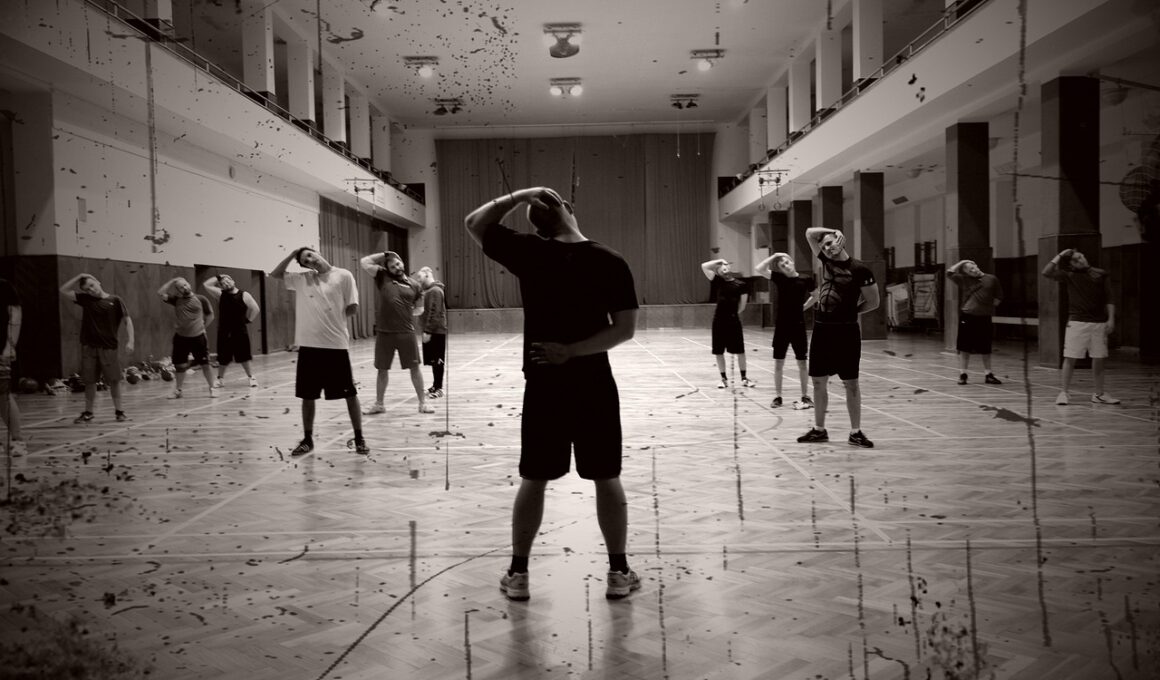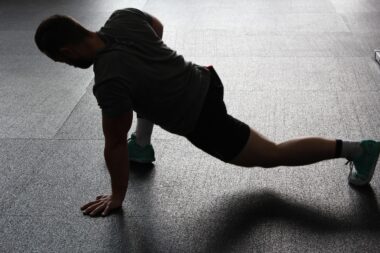Five-Minute Warm-Up Exercises for Boxing Workouts
Warming up is critical for maximizing your performance during boxing workouts and preventing injuries. A good warm-up routine prepares your muscles and joints for the specific movements you’ll perform. Start by performing light aerobic exercises for around two minutes, gradually increasing your heart rate. Common exercises include jogging in place, shadow boxing, or jumping jacks. This initial phase should elevate your body temperature and enhance blood circulation, making your muscles more pliable. Next, focus on dynamic stretches that include arm circles, torso twists, and leg swings. These movements activate the relevant muscle groups for boxing while improving your range of motion. Ensure your warm-up includes shoulder and hip mobility, as these joints are crucial for effective punching and footwork. Including exercises like ankle rolls and wrist rotations can further enhance your warm-up. Lastly, remember to be mindful of your body. If you feel tightness or discomfort during your warm-up, focus on those areas a bit more. Ultimately, a thorough warm-up prepares you not just physically, but mentally, ensuring you enter the ring with the right mindset.
A classic warm-up exercise is the jumping jack, an effective full-body movement.
This exercise integrates cardiovascular training and coordination, making it ideal for boxing preparation. To perform jumping jacks, stand upright with your arms at your sides. Jump up while spreading your legs apart and raising your arms overhead. Immediately reverse the motion to land back in the starting position. Aim for at least 30 seconds of jumping jacks, keeping a consistent pace. Following this, transition into shadow boxing, a significant routine for boxers. In shadow boxing, visualize an opponent while throwing punches in the air. This exercise not only warms up your arms and shoulders but also enhances your footwork and technique. Practicing combinations like the jab-cross or uppercuts can be effective here. Perform shadow boxing for about one to two minutes. Aim to incorporate head movement and footwork while you punch, as this helps prepare you for actual sparring sessions. To hone in on your technique, focus on your stance and balance during these movements. Shadow boxing serves as both a warm-up and a rehearsal for your actual boxing techniques.
Dynamic Stretching for Boxers
Dynamic stretching encompasses a variety of movements that increase flexibility and mobility. Not only does it warm up muscles, but it also prepares your joints for the rigors of boxing. Effective dynamic stretches include leg swings, arm circles, and torso twists. Start with leg swings by holding onto a wall for support. Swing one leg forward and back repetitively, then switch legs. Focus on keeping your posture straight to maximize effectiveness. Next, perform arm circles by extending your arms out to the side and moving them in small circles, gradually increasing the diameter. This helps to loosen the shoulders, reducing the risk of shoulder injuries. Torso twists help activate your core and lower back, key areas for generating power during punches. Stand with your feet shoulder-width apart and rotate your torso from side to side. Aim to perform these stretches for 30 seconds each, allowing your muscles to warm gradually. By integrating dynamic stretches into your boxing warm-up, you’ll increase your body’s readiness for explosive movements during workouts and enhance your overall performance.
After dynamic stretches, it’s beneficial to perform some specific mobility drills to further enhance your warm-up.
Exercises like hip circles and ankle bounces can aid in lubricating joints, crucial for the swift movements required in boxing. To do hip circles, place your hands on your hips and perform circular motions, first clockwise, followed by counterclockwise. Each direction should take about 30 seconds. This targets the hip joints, enhancing your agility. Ankle bounces are equally important; raise onto your toes and then quickly lower your heels repeatedly. This activates the calves and aids in overall footwork responsiveness. Aim for 30 seconds again with this exercise and combine them with footwork drills for about a minute. By quickly integrating movements like these into your pre-workout routine, you’ll enhance both joint functionality and your balance. It’s essential not to rush through these exercises; focus on your form and ensure that you’re feeling warmed up before transitioning into more rigorous boxing drills like heavy bag work or sparring. Remember, proper preparation is integral to a successful boxing workout.
Punching Drills as Part of Your Warm-Up
Incorporating punching drills during your warm-up can significantly enhance your boxing practice. These drills prime your body for the more intense actions you will face during your workouts. Start with simple jab exercises, focusing on technique over speed. While standing in your boxing stance, throw jabs steadily with both your dominant and non-dominant hands for about 30 seconds each. Pay attention to your footwork and ensure you are pivoting correctly, which helps harness more power in your punches. Next, move onto hooks and uppercuts, alternating between these punches while paying attention to your form. Aim to maintain your guard while executing each punch, focusing on breathing steadily as you perform the movements. This will not only warm up your upper body but also prepare your mind for the session at hand. Punching drills enhance coordination, build muscle memory, and help maintain focus under pressure. A consistent combination of these drills, lasting about two minutes, will effectively prepare you physically and mentally for a powerful workout.
As your warm-up progresses, it’s beneficial to include core activation exercises.
A strong core is essential for any boxer, as it helps with stability and power generation during punches. Start with exercises like planks and Russian twists. For planks, get into a push-up position and maintain a straight line from head to heels, focusing on your core. Hold this position for about 30 seconds, ensuring your body is aligned, and you’re engaging your abs. Following this, limit your rest time and transition smoothly into Russian twists. Sit on the floor with your knees bent and lift your feet slightly off the ground. Twist your torso from side to side, touching the floor next to you with each movement. Aim for about 30 seconds too and ensure you breathe deeply while doing these exercises. Doing these core drills will increase strength and improve your ability to absorb hits, enhancing your overall performance. A well-rounded warm-up routine effectively addresses not only your muscles but also the essential aspects of boxing fitness like agility and power.
Finishing Your Warm-Up: The Importance of Cool Down
Congratulations on completing your intense warm-up! No workout is complete without an appropriate cool down, which is essential for preventing injury.
Upon finishing your main session, dedicate a minimum of five minutes to cooling down. This can encompass light stretching and slow-paced movements. Focus on the major muscle groups utilized during your workout. Perform static stretches targeting the arms, legs, and core, holding each stretch for 15-30 seconds. This helps to slow down your heart rate gradually and aids in reducing muscle stiffness. Incorporate deep breathing during your cool down to enhance oxygen flow and encourage relaxation, familiarizing your body with the end of a rigorous activity. Engaging in this practice routinely will significantly promote flexibility and recovery, playing a significant role in sustaining your performance as a boxer. Post-workout nutrient intake is just as important, so ensure you refuel with protein and carbohydrates after training sessions. Reducing muscle soreness and tiredness will keep you training consistently. A mindful conclusion to your boxing sessions can create a more fruitful long-term fitness journey.
In summary, warming up properly before your boxing workouts is not merely a suggestion but a necessity for optimal performance.
By engaging in these five-minute warm-up exercises, you can enhance your flexibility, agility, and readiness for the rigors of boxing. From aerobic activities and dynamic stretches to punching drills and core work, each component serves its purpose in preparing your body. Remember, the warm-up will also mentally prepare you by getting you into the right mindset for training. Taking time for a thorough warm-up sets the foundation for your main boxing workout sessions, allowing you to challenge yourself while reducing injury risk. By following these structured routines, you’ll be empowering your overall boxing management, promising you enhanced effectiveness in sparring and competitive scenarios. Don’t forget to take time post-workout for a cool-down session as a critical balance—helping keep muscle recovery at its prime. Consistency in these practices not only makes for a better workout but a more enjoyable boxing journey, too. Train smart and enjoy every moment, knowing you have equipped yourself with the tools necessary for success.





